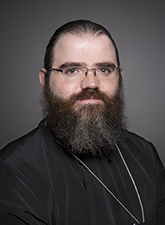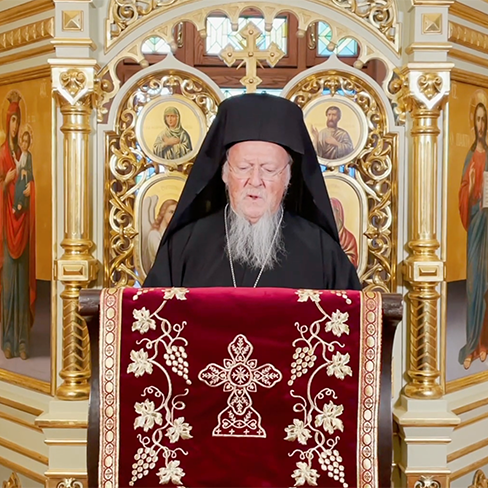The Appearances of Christ
“…being seen by them for forty days…”
+Fr. Loukas Gikas, St. John Chrysostomos Monastery - Pleasant Prairie, WI | April 30, 2020
 CHRIST IS RISEN! “Today is salvation come unto the world, to that which is visible, and to that which is invisible,” Saint Gregory the Theologian exclaims in his Paschal Homily. Pascha is the feasts of feasts which supersedes all celebrations. The Resurrection of Christ nurtures the rebirth of humankind for those “who were born, not of blood, nor of the will of the flesh, nor of the will of man, but of God,” as the Evangelist John affirms. Pascha transforms our life and introduces us into a different mode of being. Pascha marks the end of darkness and the beginning of all that is good through the ushering in of “new creation,” since the “old things have passed away” and “all things have become new.”
CHRIST IS RISEN! “Today is salvation come unto the world, to that which is visible, and to that which is invisible,” Saint Gregory the Theologian exclaims in his Paschal Homily. Pascha is the feasts of feasts which supersedes all celebrations. The Resurrection of Christ nurtures the rebirth of humankind for those “who were born, not of blood, nor of the will of the flesh, nor of the will of man, but of God,” as the Evangelist John affirms. Pascha transforms our life and introduces us into a different mode of being. Pascha marks the end of darkness and the beginning of all that is good through the ushering in of “new creation,” since the “old things have passed away” and “all things have become new.”
In the liturgical life of the Church, during this period of Pascha through Pentecost, the Epistle readings of our worship services are generally selected from the Acts of the Apostles. Saint Luke informs us that, following Christ’s Resurrection, He revealed Himself to His disciples “for forty days.” Christ made several live appearances to various people over this short period of time. Let us take a closer look at a few of these appearances.
APPEARANCES TO THE THEOTOKOS
In their Gospels, the Evangelists recount the details surrounding the Resurrection. The Myrrh-bearing women were the first to experience this, which occurred at different times of the day. Saint Matthew uses the phrase “as the first day of the week began to dawn,” John “while it was still dark,” Luke “very early in the morning,” and Mark “when the sun had risen.” Thus, some of the Myrrh-bearers went to the tomb at daybreak, while others went when it was still dark. Certainly, all the Myrrh-bearing women are worthy of praise. Yet, some Fathers pay special attention to one of them: the other Mary or Mary the mother of James. The other Mary is the Mother of God, the Panagia.
Saint Gregory Palamas observes that it was necessary and just for the good news of the Lord’s Resurrection to be first proclaimed by Christ Himself directly to His mother, the Theotokos. She was the first to hear the risen Lord speak, she saw Him first, and perhaps embraced Him. She is referred to as Mary the mother of James and Joses because Joseph’s children from his first wife were named as such. Thus, the Evangelists refer to the Theotokos in a concealed way, so as not to be criticized for bearing witness to the Resurrection by one of Christ’s direct family members. Just as she was the first to hear the greeting “Hail” from the Angel during the Annunciation, she too was likely the first person to hear the first greeting from the risen Lord.
As such, the All-holy Theotokos was the first to experience the event of her Son’s resurrection. Such an opinion is preserved in the hymnology of our Church which proclaims: “Thou didst meet the Virgin and didst grant us life.” It is natural that the Theotokos, who was present during many of Christ’s public appearances, was the first to be informed of the greatest even in history: the Lord’s Resurrection.
APPEARANCES TO THE DISCIPLES
While in Paradise, Adam was adorned with God’s grace and although he was naked, he was not at all embarrassed. The same principle can be applied to physical body of the risen Lord. He was not covered in human clothes but vested in divine glory. He bore the light of the Resurrection as a shroud. Theophanes Kerameus, a 12th century bishop of Calabria and celebrated homilist, states characteristically that Christ “radiated a beautiful and vibrant glory.” This is likely why various disciples had trouble recognizing Him, whereas others worshiped Him. The three disciples who witnessed His glory during the Transfiguration, recognized Jesus. They saw how the glory of the Transfiguration was identical to the light of the Resurrection. The radiant figure of the Lord is the source of authentic human glory. All people who will be saved will become divine, because “as is the heavenly Man, so also are those who are heavenly.” We shall also come to “bear the image of the heavenly Man,” Jesus, the God-Man.
THE LIGHT OF CHRIST AND CREATION
Next, the vision of Christ’s burial shrouds serves as a clear manifestation of the Resurrection. Seeing the linens on the ground, Peter was amazed, for “stooping down, he saw the linen cloths lying by themselves; and he departed, marveling to himself at what had happened.” The Light of the Resurrection caused the tomb to shine bright. God’s grace penetrated everything. The Myrrh-bearers and the Apostles were able to see the interior of the tomb quite clearly, because the heavenly, uncreated light of the Lord had illuminated all things. Saint Gregory of Nyssa clearly explains: “The tomb was full of light, so, even though it was dark inside, the interior was visible in both a physical and spiritual manner.” Those who were present were able to appreciate the Resurrection with their physical eyes, but also spiritually through their faith. In the well-known hymn from the Paschal canon we hear: “Now all things are filled with light: heaven and earth, and the nethermost regions.”
“HAVING BEHELD THE RESURRECTION OF CHRIST…”
As our Church has been gathering in one liturgical body for two thousand years, and certainly at every Divine Liturgy, we have been confessing that: “We have beheld the Resurrection of Christ.” Saint Symeon the New Theologian asks, how can we come to appreciate what the Apostles experienced some two thousand years ago? The Saint answers by saying that in each one of us who believes, in every hour of every day, the mystery of the Lord’s resurrection is constantly being revealed. Within our souls, Christ is being revealed through the flashing light of His divinity.
Through the Mysteries of the Church, and certainly in the Divine Liturgy, we “proclaim His death and confess His resurrection.” While Thomas was alone, he was unable to grasp the truth of the Resurrection. However, when he was in the presence of his brother Apostles, he was able to see Jesus. Unity in Liturgy enables us to experience the realities of the resurrection.
Beloved brothers and sisters, the universal good news of the Resurrection is also the good news of our own personal renewal, a call to cast off the life of sin. Let us experience the Resurrection personally in our lives, so that we can disseminate the Paschal message into the world, chiefly with our way of life, but also with our words. CHRIST IS RISEN – TRULY HE IS RISEN!
Translated and adapted from Epiousios Artos by Metropolitan Joel Frangkakis. Apostoliki Diakonia. Athens, 2010. pp.21-24.
+Fr. Loukas Gikas
- Acts 1:3
- John 1:13
- 2 Corinthians 5:17
- Acts 1:3
- Matthew 28:1
- John 20:1
- Luke 24:1
- Mark 16:2
- Matthew 28:1
- Luke 24:10
- Mark 15:47
- Resurrection apolytikion of the plagal second (sixth) tone.
- Genesis 2:25
- Matthew 28:17
- 1 Corinthians 15:48
- 1 Corinthians 15:49
- Luke 24:12
- Ode 3
- Divine Liturgy of Saint Basil




